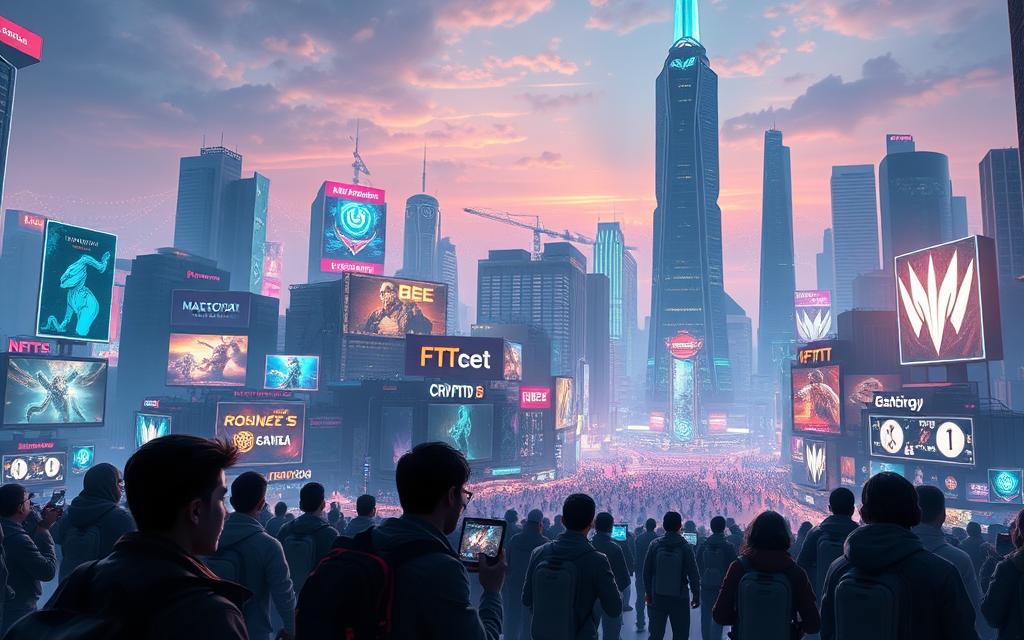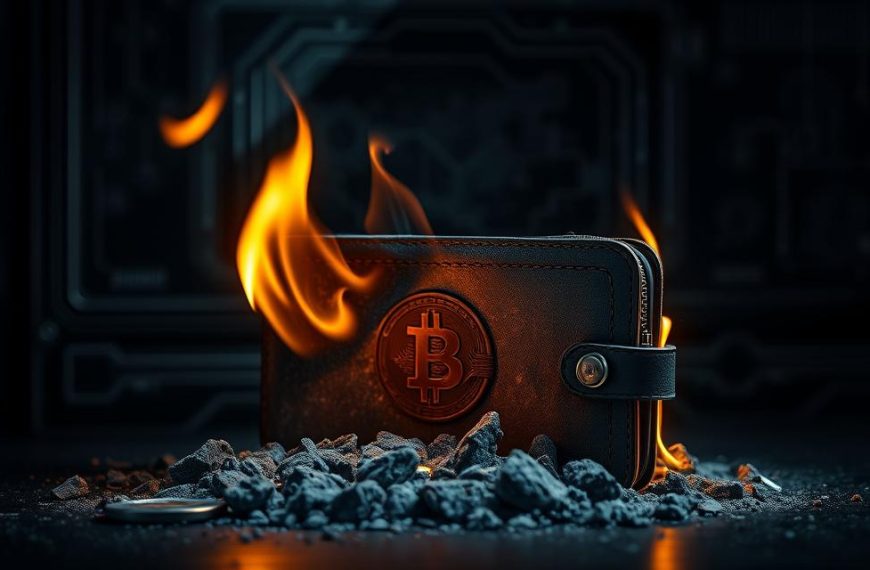Crypto gaming merges interactive entertainment with blockchain technology to create digital economies where items can carry real-world value.
The trend began with early experiments in 2017 and drew broad attention around 2021. Milestones include CryptoKitties, which stressed Ethereum, and Axie Infinity, famous for play-to-earn and later the Ronin bridge exploit.
Players are drawn by genuine ownership, tradable assets, cross-platform visibility and the chance to earn via in-game activity.
At the same time, critics point to speculation, environmental costs, user learning curves and shaky regulation. Major platforms split on policy: Valve banned blockchain titles while Epic signalled openness. Publishers such as Ubisoft and Mojang met mixed responses to NFTs.
This guide aims to be a measured resource. It will explain the technology stack, game models, monetisation routes, risks and the evolving ecosystem for users and the wider industry.
Introduction: the present state of crypto gaming and player interest
Today the landscape reads as measured experimentation: a few major studios and storefronts test blockchain features while others reject them outright. Valve banned blockchain titles on one hand, and Epic signalled conditional openness on the other, shaping how developers publish and distribute games.
Many players seek tradable assets, marketplaces and potential returns. Yet a large share of traditional gamers remain sceptical because of scams, speculation and perceived compromises to gameplay.
The market keeps innovating with better wallets, sidechains and clearer token models. Still, mass adoption will depend on simple onboarding, fun-first design and platform compliance.
- Developer sentiment: surveys show most studios avoid NFTs and crypto payments.
- Investment reality: token values are volatile; returns are uncertain.
- Experience matters: smoother wallets and fewer friction points will drive user growth.
This guide will help you judge ecosystems rather than single titles, focusing on utility, governance and longevity to separate durable projects from short‑lived speculation.
What is crypto gaming?
Digital play now pairs classic mechanics with distributed ledgers to give items provable ownership and market value.
Core concepts: gaming meets blockchain technology
Blockchain acts as a public ledger that records transfers of unique and fungible digital assets. That record creates scarcity and traceable provenance for in‑game assets.
Core primitives include cryptocurrencies for payments and rewards, NFTs that represent unique characters, skins or land, and tokens used for utility or governance.
Key terms explained
- Wallets: secure key managers that let players hold tokens and in‑game items.
- Smart contracts: code that automates marketplaces, crafting or reward distribution without a central intermediary.
- DAOs: community governance structures that let holders vote on updates or treasury use.
“On‑chain records govern ownership; off‑chain systems handle rendering and physics for performance.”
Items such as land parcels, cards or avatars can become tradable NFTs. That portability improves liquidity and price discovery, but value remains speculative and linked to scarcity, utility and wider market cycles.
How crypto gaming works: from blockchains to in‑game items
Blockchains record every transfer, creating an auditable trail for in‑game assets and player trades. That public record underpins verifiable scarcity and provenance for tokens and unique items.
Blockchain integration and data transparency
Games write ownership and transaction records to chains so anyone can check history. This transparency helps prevent fraud and shows provenance for rare items.
Transparency does not remove risk: bugs or bridge exploits can still put funds at risk.
Wallets and cryptocurrencies used for purchases, rewards, and trading
Players set up wallets that hold private keys and seed phrases. Wallets send and receive tokens for purchases, staking and reward claims.
Best practice: start with small transactions and verify contract addresses before sending funds.
NFTs as unique in‑game items and true ownership
NFTs act as on‑chain certificates for skins, land or avatars. Game logic often runs off‑chain for performance while ownership lives on the ledger.
Smart contracts automating gameplay mechanics and marketplaces
Smart contracts enforce rules for crafting, trades, rentals and reward distribution without manual intervention. Audits and reputable platforms reduce—but do not eliminate—risk.
DAOs and player governance shaping game roadmaps
DAOs let token‑holders propose changes, vote and influence treasury spending. Voting thresholds and quorum rules determine what actions pass.
Moving assets to liquid markets uses decentralised exchanges or on‑ramps. Expect fees, slippage and network costs; layer‑2 and sidechains aim to reduce fees and speed up transfers.
“Immutable records and smart contracts can automate trust, but technical flaws and economic design still shape outcomes.”
| Component | Role | Primary risk |
|---|---|---|
| Blockchain | Immutable ownership ledger | Bridge and contract exploits |
| Wallets | Key custody, transfers | Phishing, lost seed phrases |
| NFTs | Unique in‑game assets | Value volatility, interoperability limits |
| Smart contracts | Automated mechanics & markets | Logic bugs, frozen funds |
| DAOs | Community governance | Low participation or token concentration |
Game models: Play‑to‑Earn vs Play‑and‑Own mechanics
Two dominant economic designs shape modern titles: reward-driven play loops and ownership-first markets.
Play‑to‑Earn distributes on‑chain rewards—tokens or NFTs—based on time, skill, quests or contributions. These systems convert activity into tradable value, letting players earn while they play. Monetisation loops control token flow by adding sinks (fees, crafting costs) and emissions (daily rewards) so supply and demand stay balanced.
Play‑and‑Own focuses on true possession: in‑game items become NFTs that players can trade, hold or use. Value here comes from rarity, gameplay utility and creator reputation rather than guaranteed income. Utility in matches, tournament play or crafting makes assets meaningful.
Hybrid models combine cosmetics, limited rewards and durable assets to reduce hyper‑financialisation. Regulators may view reward tokens differently across jurisdictions, so token design and disclosures matter.
“Entertainment quality remains decisive; engaging design sustains player interest and healthier economies.”
| Model | Primary flow | Sustainability risk | Value drivers |
|---|---|---|---|
| Play‑to‑Earn | Activity → token rewards → trade | Rewards exceed demand; inflation | Token utility, scarcity, active user base |
| Play‑and‑Own | Purchase or earn items → true ownership | Speculation without utility | Rarity, in‑game use, creator credibility |
| Hybrid | Cosmetics + selective token rewards | Complex tokenomics; design errors | Balanced sinks, engaging gameplay, community |
Getting started: choosing games, wallets, and understanding costs
Begin by narrowing choices to reputable titles with clear roadmaps and active communities.
Select a game and assess the ecosystem: review whitepapers, tokenomics and developer history. Join Discord or forum channels to judge community health and roadmap delivery. Prefer projects with audits and transparent marketplaces.
Create a compatible wallet and account: choose between custodial services for ease or self‑custody for control. Ensure network compatibility with the game’s chain and back up seed phrases before funding. Link accounts only through official sites and expect KYC for some platforms.
Understand entry costs and payment routes: factor in starter packs, required NFTs, gas fees, marketplace commissions and season passes. Buy cryptocurrencies via regulated exchanges or on‑ramps, or use gift cards where supported by major brands.
Practical tips: test on low‑cost networks first, verify contract addresses, use hardware wallets for larger holdings and set strict budgets to limit investment risk.
“Start small, learn mechanics, and treat in‑game assets as speculative holdings.”
Ways players earn and trade in crypto games
Market dynamics and gameplay loops together shape how users convert effort into real value.
Asset trading and exchanges: tokenomics, liquidity, and value
Marketplaces use order books or AMMs to match buyers and sellers. Liquidity depth and issuance rates affect price shifts.
Tokenomics — issuance, burning sinks and reward schedules — directly set long‑term value and inflation risk.
Gameplay rewards: quests, tournaments and creator content
Rewards come from quests, ranked play and organiser prize pools. Platforms like Stepn show how off‑game activity can earn users tokens.
Creators earn via sales, royalties and revenue shares for maps or mods that attract users.
Staking, yield and early investment paths
Locking tokens or NFTs yields APRs but carries smart‑contract and lock‑up risk. Early mints and founder passes offer upside but remain highly speculative.
Plan off‑ramps: convert holdings to fiat, factor taxes and follow local compliance.
“Profitability depends on cycles, execution and time; it is never guaranteed.”
| Mechanic | How it pays | Key risks | Typical users |
|---|---|---|---|
| Marketplace trading | Buy/sell assets for profit | Low liquidity, price swings | Traders, speculators |
| Tournament rewards | Prize pools, sponsorships | Skill variance, prize dilution | Competitive players |
| Staking/Yield | APR, token rewards | Contract bugs, lock‑ups | Long‑term holders |
| Early investment | Mint flips, founder perks | Project failure, rug pulls | Investors, collectors |
Risks and criticisms you should know before you play
Before you join any title, weigh the technical and economic downsides that often hide behind glossy trailers.
Scalability, speed and fees
High demand can clog networks. That causes slow confirmations and steep fees that ruin the player experience.
Historic outages—such as congestion that froze marketplaces—show performance matters as much as design.
Interoperability and portability
Different chains and token standards hinder moving assets between titles. This limits composability and long‑term value.
Security, privacy and self‑custody
Smart contract bugs and bridge exploits have drained millions. Public ledgers also expose transaction history and identity links.
Self‑custody has a steep learning curve—lost seed phrases mean irreversible loss.
Markets, rules and fairness
Price swings, shifting regulation and bans by major storefronts can remove liquidity or block access.
Poor economy design and pay‑to‑win mechanics risk exploitation and user churn.
“Treat assets as speculative; protect keys and verify contracts before you commit.”
| Risk | Impact | Mitigation | Example |
|---|---|---|---|
| Scalability | Slow play, high fees | Use layer‑2, pick low‑fee chains | Network congestion during peaks |
| Security | Fund loss, frozen assets | Audit contracts, limit approvals | Bridge exploits |
| Regulation | Restricted access, tax exposure | Follow KYC rules, check local law | Storefront bans, AML checks |
| Economy design | Inflation, unfair play | Balanced sinks, transparent governance | Unsustainable reward models |
Popular crypto games and ecosystems to watch
A handful of games have defined key lessons about token flows, governance and user retention. Below are ecosystems that matter for players and investors, plus notes on liquidity and risks.
Axie Infinity
Axie Infinity pioneered play‑to‑earn with SLP and AXS token dynamics and guild economies. Early success brought rapid user growth, but the March 2022 Ronin exploit underlined custody and bridge risks.
Lesson: token emissions must match demand; security and transparent treasuries matter.
Decentraland (MANA)
Decentraland sells LAND as NFTs and uses MANA for purchases and governance. Users build experiences on parcels and vote on policy via DAO mechanisms.
The Sandbox (SAND)
The Sandbox combines voxel creator tools, LAND sales and SAND transactions. Creator incentives and partnerships drive secondary markets and staking options for contributors.
Gods Unchained
This card title emphasises true ownership and active secondary markets. Skilled play and collection strategies can yield value through trading and organised tournaments.
My Neighbor Alice
My Neighbor Alice centres on community island‑building and event-driven ALICE utility. Social features and customisation foster longer retention and local economies.
Notcoin & TON tap‑to‑earn
Notcoin showed how frictionless distribution—via Telegram—can reach millions. Tap‑to‑earn mechanics, viral referrals and later token trading created huge volume, but also speculative pressure.
“Monitor roadmaps, dev updates and on‑chain activity to judge ecosystem health.”
| Platform | Primary value drivers | Liquidity notes |
|---|---|---|
| Axie Infinity | Play rewards, guilds, IP | High early volume; sensitive to token supply shocks |
| Decentraland | Virtual land, events, DAO governance | LAND trades on major exchanges; parcel scarcity supports prices |
| The Sandbox | Creator economy, partnerships | Active marketplaces; fees and staking affect returns |
Risk reminder: speculation, supply overhangs and policy shifts can erode value quickly. Track trading depth and developer cadence before committing funds.
Industry adoption, platforms, and payment routes
Access to major marketplaces often decides a project’s visibility and sales.
Publishers and storefronts shape distribution and discoverability. Valve’s Steam forbids blockchain/NFT titles, while Epic accepts compliant releases. Mojang banned NFTs for Minecraft, and Ubisoft’s Quartz experiment on Tezos faced heavy user backlash and very low trading activity.
Why this matters: platform policies affect reach to mainstream gamers, rules for payments and listing approval. Developers must meet storefront terms and regional law to avoid delisting or restricted access.
Payment routes and indirect spending
Major console owners—Microsoft, Sony and Nintendo—do not broadly accept cryptocurrencies directly. However, users can often buy official gift cards from approved partners using digital assets, then redeem them in stores.
Practical notes: indirect spend removes chargeback protections and can complicate tax reporting when converting holdings to fiat. Custody risks remain: use vetted exchanges or services and keep records for compliance.
Compliance, regional limits and content claims
Regulation and partner support vary by jurisdiction. Some on‑ramps require KYC/AML checks and terms may forbid items with real‑world value in certain markets.
- Check local availability before listing or buying.
- Ensure marketing claims about ownership, rewards or returns are accurate and not misleading.
- Expect platforms to revisit policies as regulation and infrastructure evolve.
“Storefront and publisher rules will continue to steer how projects design token features and payment flows.”
The future of crypto gaming: metaverse, AR/VR, and mainstream integration
Persistent virtual worlds will increasingly bind player identity and item ownership to verifiable ledgers. That convergence can let an avatar, a rare skin or a profile carry value across connected experiences.
AR and VR will make those interactions tactile. Players could enter immersive social hubs, showcase creator content and handle owned assets with intuitive gestures.
Governance will grow more granular. Expect transparent voting, revenue‑share mechanics for creators and clearer treasury rules that reward contributors fairly.
Technical pathfinders—scalability upgrades, account abstraction and better wallet UX—will cut onboarding friction and drop fees for everyday use.
“Fun‑first design must lead; financial features should augment play rather than replace it.”
Cross‑title standards will improve portability and utility for tokens and nfts, while platforms and regulators will shape permissible marketing claims.
Creators stand to gain via on‑chain attribution and royalties. For deeper analysis, see the discussion on impact of AR, VR and blockchain in the.
Conclusion
This era links player-driven markets with programmable ownership, reshaping how digital items gain value.
Crypto gaming blends ownership and programmability with play, creating markets for in‑game assets, tokens and rewards. Models range from play‑to‑earn to play‑and‑own, each with different sustainability pressures.
Choose reputable crypto games, secure wallets, and use exchanges prudently. Never risk money you cannot afford to lose.
Do due diligence: read tokenomics, governance rules and legal disclosures. Study cases such as Axie Infinity to learn about security and market cycles.
Market realities — liquidity, volatility and regulation — will shape value and access. Prioritise gameplay and community health when evaluating projects.
Takeaway: start small, learn steadily, and favour projects that pair fun with fair economies and transparent governance.




















